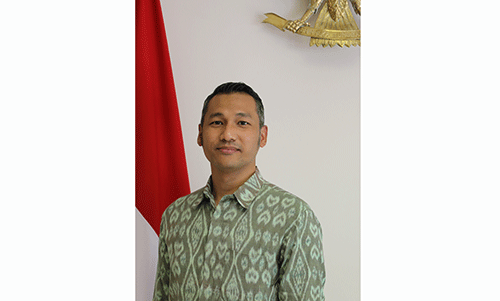Ari Hadiman
The role and contribution of the creative economy to the national economy have gained traction globally. In that context, many countries around the globe devoted much attention to developing a creative economy as it has a considerable potential impact to support economic growth.
In Indonesia, the creative economy sector accounted for 7.4% of the GDP in 2017. The Ministry of Tourism and Creative Economy found that, during the pandemic, the creative economy sector in Indonesia grew by 4.04% in 2021. Recognizing the positive impact of the creative economy, Indonesia has made several concrete moves to mainstream and develop the creative economy at the national and international levels.
In 2018, Indonesia hosted the First World Conference on Creative Economy (1st WCCE), which served as a forum to promote the creative economy by identifying opportunities, resolving challenges, and exchanging ideas. The following year, 2019, Indonesia was the main sponsor of the proposal at the United Nations General Assembly to declare the year 2021 as the International Year of Creative Economy, which was adopted by consensus on 14 November 2019.
Indonesia also supported United Arab Emirates (UAE) to host the 2nd WCCE in 2021. Following the successful events, Indonesia will host the 3rd WCCE from 5 to 7 October 2022 in Bali, under the main theme ‘Inclusively Creative: A Global Recovery’ stressing the importance of creative economy integration into the global economic recovery, especially post- pandemic recovery strategies.
Four main activities will be the highlight of the 3rd WCCE: the Ministerial Meeting, Panel and Spotlight Session, Friends of Creative Economy Meeting and WCCE Expo.
The conference coincides with Indonesia as the President of G-20 in the year 2022, which is expected to give a boost for the further impact of the creative economy on the global economy as well as the opportunity for policy formulation that increases the capacity of a creative economy.
Economic growth and employment creation
With regard to policy formulation, the government provides various policies to sustain the contribution of the creative economy to GDP. The nature of the creative economy revolves around the wealth generation through the added value of an intellectual property from human creativity based on culture, heritage, science, and technology. The creative economy covers various sectors, among others, including music, fashion, performing arts, movies, animation, culinary, architecture,
tourism and cultural goods, and interior design to game development.
The broad coverage reflects the huge potential of the creative economy could contribute to national economic growth.
In view of the broad coverage of the creative economy, the government should devise policies to create and sustain the network and connectivity between players or business actors that create additional value for the industry.
In this relation, the value chain of the creative economy comprises creation, production, distribution, consumption, and conservation. The chain requires the collaboration of five different stakeholders, or Pentahelix, consisting of the government, academics, communities, entrepreneurs and media. The collaboration of the five parties will further create value-added as well as employment. Employment creation in the creative economy is highly interdependent.
As the backbone of the creative industry lies in the ever-developing individual creativity, the influence or growth of a particular sector will create opportunity and
foster the development of other sectors.
For instance, individual creativity generates innovation in the IT sector leading to numerous development and job opportunities in other industries, such as the gaming industry, media industry or music and movie industry.
Globally, based on UN estimation, the creative industry contributes to 50 million jobs. In Indonesia, according to a senior official of the Ministry of Tourism and Creative Economy, the creative economy created jobs for 19.39 million workers in 2020.
In Africa, the importance of a creative economy is acknowledged by prominent scholars and other stakeholders.
According to UNESCO, the movie and audio industry in Africa was expected to create more than 20 million jobs and an additional US$20 billion in annual revenue.
Supporting creative economy in Namibia
Namibia has the potential to develop a creative economy. Utilising the latest IT development, the people of Namibia experience and benefit from internet-based commercial activity such as ride-hailing applications, innovative food and goods delivery app, and internet marketing.
With regard to IT development and business opportunity, the Embassy of Indonesia in Windhoek has facilitated the agreement between Telkom University (Tel-U) Indonesia and Namibia University of Science and Technology (NUST) in June 2022.
The agreement is expected to support NUST in developing business incubators and supporting start-up businesses in Namibia, which are mainly driven by the youth.
Namibian youth could benefit enormously from the latest IT development.
They could tap into various applications for internet marketing purposes or to enhance their skill and capacity to generate direct income. The path to developing a creative economy in Namibia will require several aspects, such as an increase in human capital and capacity, providing access to capital and funding, formulating policies, and open access to the local and global markets.
Looking from a broader perspective, the Namibian’s creative industry could use the African African Continental Free Trade Area (AfCFTA), which creates a free flow of goods and services as well as capital.
AfCFTA would provide wider access for Namibians to obtain capital or fund as well as a market to distribute the products.
In addition, AfCFTA would present opportunities to the creative industry in Namibia for collaborating with other partners in African countries and non-African countries, including Indonesia.
In this connection, the 3rd WCCE on 5 to 7 October 2022 in Indonesia will certainly serve the purpose of Namibian stakeholders to identify possible instruments to develop a creative economy and overcome challenges through international collaboration, policy formulation, and capacity building.
*Ari Hadiman is the head of the department for Information and Socio-Culture Affairs, the Embassy of Indonesia, in Windhoek. The views and opinions expressed in this article are those of the author.


